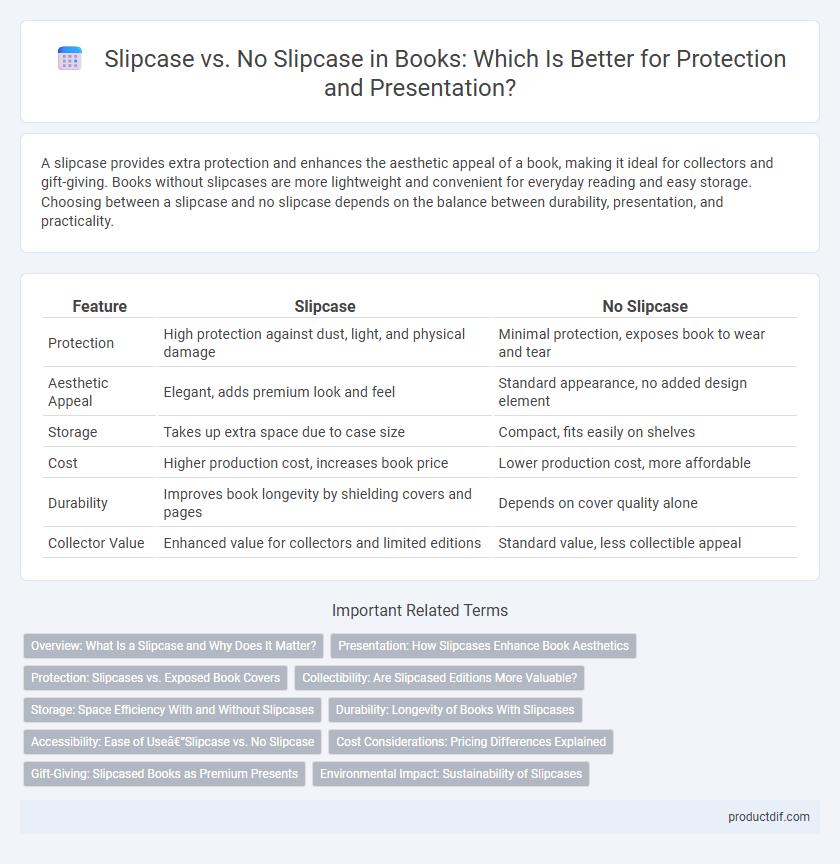A slipcase provides extra protection and enhances the aesthetic appeal of a book, making it ideal for collectors and gift-giving. Books without slipcases are more lightweight and convenient for everyday reading and easy storage. Choosing between a slipcase and no slipcase depends on the balance between durability, presentation, and practicality.
Table of Comparison
| Feature | Slipcase | No Slipcase |
|---|---|---|
| Protection | High protection against dust, light, and physical damage | Minimal protection, exposes book to wear and tear |
| Aesthetic Appeal | Elegant, adds premium look and feel | Standard appearance, no added design element |
| Storage | Takes up extra space due to case size | Compact, fits easily on shelves |
| Cost | Higher production cost, increases book price | Lower production cost, more affordable |
| Durability | Improves book longevity by shielding covers and pages | Depends on cover quality alone |
| Collector Value | Enhanced value for collectors and limited editions | Standard value, less collectible appeal |
Overview: What Is a Slipcase and Why Does It Matter?
A slipcase is a protective cover, typically made of sturdy cardboard or wood, designed to encase one or more books, enhancing durability and aesthetic appeal. It matters because slipcases shield books from dust, light exposure, and physical damage while providing an elegant presentation, often increasing the collectible value. Collectors and publishers prioritize slipcases for their combination of protection and visual sophistication, making them a preferred choice for special editions and box sets.
Presentation: How Slipcases Enhance Book Aesthetics
Slipcases significantly elevate book presentation by offering a protective and visually appealing enclosure that highlights the book's design and craftsmanship. Their sturdy construction and often decorative exterior create a sense of luxury, making books stand out on shelves or coffee tables. Slipcases also prevent wear and fading, preserving the book's pristine condition and enhancing its overall aesthetic appeal.
Protection: Slipcases vs. Exposed Book Covers
Slipcases provide superior protection by encasing books in a sturdy, dust-resistant cover that shields against scratches, light exposure, and environmental damage. Exposed book covers, while visually accessible, are vulnerable to wear and tear, including bent corners, spine creases, and dust accumulation. Collectors and avid readers often prefer slipcases to preserve the book's condition and longevity.
Collectibility: Are Slipcased Editions More Valuable?
Slipcased editions often enhance collectibility due to their added protection and aesthetic appeal, which can maintain or increase a book's condition and desirability over time. Collectors frequently seek slipcased books as they are considered premium or limited editions, potentially commanding higher resale value in the rare book market. However, the actual value depends on factors like rarity, edition, and demand, not solely the presence of a slipcase.
Storage: Space Efficiency With and Without Slipcases
Books stored with slipcases require more shelf space due to the added external cover, which can reduce overall storage capacity. Without slipcases, books fit more compactly on shelves, optimizing space efficiency for large collections. However, slipcases offer additional protection from dust and damage, potentially preserving book condition despite taking up extra room.
Durability: Longevity of Books With Slipcases
Books with slipcases experience significantly enhanced durability, as slipcases offer crucial protection against dust, sunlight, and physical damage, preserving the book's condition over time. The sturdy outer enclosure minimizes wear on the book's cover and spine, extending the lifespan of both hardcover and special edition volumes. Collectors and bibliophiles often prefer slipcases to maintain the book's value and appearance through prolonged use.
Accessibility: Ease of Use—Slipcase vs. No Slipcase
Slipcases provide enhanced protection for books, making them easier to store and carry without damage, which benefits users who prioritize durability. However, slipcases can add bulk and require extra effort to remove or replace the book, potentially hindering quick access for those with limited dexterity. Books without slipcases offer straightforward handling and immediate access, improving usability for readers seeking convenience over long-term preservation.
Cost Considerations: Pricing Differences Explained
Slipcases typically increase production costs due to additional materials and assembly, resulting in higher retail prices compared to standard editions without slipcases. The protective and aesthetic benefits of slipcases justify the price difference for collectors and gift buyers who value presentation and durability. Budget-conscious readers often opt for no slipcase editions to enjoy lower costs while sacrificing extra protection and visual appeal.
Gift-Giving: Slipcased Books as Premium Presents
Slipcased books enhance gift-giving by offering a premium presentation that protects and showcases the book's quality, making them ideal for special occasions and collectors. The sturdy slipcase adds an elegant touch and increases perceived value, making the gift feel more thoughtful and luxurious. Without a slipcase, books may lack the added layer of protection and sophistication that elevates the gift experience.
Environmental Impact: Sustainability of Slipcases
Slipcases typically use additional materials such as cardboard and paperboard, increasing resource consumption and waste compared to books without slipcases. However, slipcases made from recycled or sustainably sourced materials can reduce environmental impact and promote eco-friendly packaging. Choosing slipcases with certified sustainable materials supports greener publishing practices while providing added protection for books.
Slipcase vs No Slipcase Infographic

 productdif.com
productdif.com